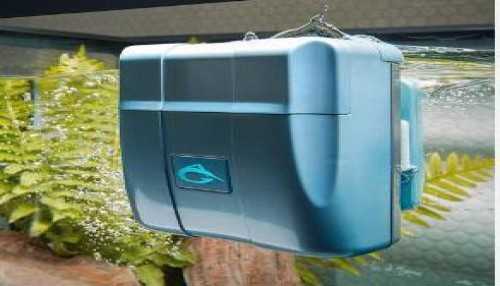Milan Rafailovich from San Diego has invented the world’s first and only automated aquarium glass cleaner. The RoboSnail, as it is called, prevents algae from building up on the glass surface. Aquarium owners will be well aware of the fact that it takes 6 months to a year for pungent algae to build up. Aquariums need daily cleaning and that’s what RoboSnail delivers once a day without requiring any intervention.
Owner of AquaGenesis, the company that makes RoboSnail, Milan Rafailovich has definitely made life a little easier with the robotic cleaner that is receiving rave reviews from initial sales. Automated innovations are always in a unique position as being the ‘one of a kind’ devices and products. They don’t have any direct substitutes so whatever the product is, it has to be right the first time. That’s certainly something RoboSnail has accomplished but is it too early to make claims?
Development & Features
After impressing a robotic engineering firm with their idea of an aquarium cleaner controlled by a widget, Milan Rafailovich finally developed a prototype that meets batch production requirements. The end product had to be made of high-grade materials in a compact size while keeping costs in check. Still getting to this point was not a walk in the park: “The total process took about 3 years and they had to go through a dozen iterations before they found something reliable. There were plenty of days where it looked like this thing would never work or that it would not be practical for the mass market but this did not get the better of me” Milan told us.
After 10 years of work and many prototypes, the RoboSnail is a carefully developed and lightweight automatic aquarium cleaner. After fairly simple programming and installation, the RoboSnail can be used for daily cleaning. Featuring a smart sensing technology, the cleaner detects the dimensions of the aquarium and saves the pattern of cleaning in its internal memory. It then cleans the aquarium glass on a daily basis to prevent algae from building up.
The battery of the cleaner lasts 30 minutes, and it automatically hovers back to the charging station to recharge. It takes less than an hour to set up RoboSnail and that’s about it from then. It requires low key maintenance, ideally once every two months. Since the product is a recent innovation, it will take time before it gets software updates, but they are already in the development pipeline. As sales pick up, AquaGenesis will discover where its potential market lies.
Market
Since it launched last year, the sales numbers bode well for the future of RoboSnail. The company has benefited from major press coverage including an article in the New York Times. The RoboSnail works for standard 55 to 150-US-gallon glass aquariums, which is the standard capacity range for home aquariums. It works with rimless, freestanding, and even wall-mounted aquariums, which sums up three basic aquarium types for homes and offices.
An upgrade to the current model now allows the product to work on aquariums that are 1/2 thick and up to and 300 gallons. This is a change that took place in July after the NY times article. This is a major plus because many people with larger tanks will now be able to use the product. In some cases, the product can work on tanks larger than 300 gallons depending on the construction but as a standard, the new upgrade rates for 100-300 gallon aquariums.
Now, a whole different challenge of marketing a ‘first in the market’ product awaits AquaGenesis. While social media, PPC, and other digital marketing strategies are already in place, many first-ever product makers have a hard time capitalizing on them.
As Milan said, “product launch may seem like the final step, but it is also a whole new undertaking. Finding the right partners, negotiations, placement, branding, and price point will also take much time. Many people want to know more information than what is available before they feel comfortable purchasing the product. As a consequence, they do their best to reassure the public by standing 100% behind what they created.” That being said, based on the positive feedback the RoboSnail has received so far, AquaGenesis will not have much trouble selling it if the reviews remain so positive.
Outlook
The RoboSnail and AquaGenesis have been in the making for close to 10 years, and the concept only started taking shape 4 years ago. It is a carefully planned and developed product, filling a very specific need in an efficient way. The programming is as simple as it gets. With regular software updates, RoboSnail will improve over time. Now, AguaGenesis’ main focus is on marketing and communication in order to increase RoboSnail’s visibility.
Milan is confident when it comes to the future: “They are very proud of what they created and if they have done everything the right way they can also feel proud in offering these assurances. This is a nice old fashioned mentality which will help build long-term success for a company.”
Being the first-ever robotic aquarium glass cleaner, RoboSnail definitely has a reputation to live up to. Milan Rafailovich has imagined, prototyped, developed, manufactured and brought to market an award-winning product. Their company has a bright future.
RoboSnail
The idea behind Robosnail was to take over the drudgery of cleaning algae and slime off the walls of an aquarium in order to keep the inside sparkling clean and easy to see through. As any aquarium owner can tell them, that’s a thankless and never-ending task. Some types of fish, as well as living snails, will do the job, but it usually takes a human touch to get it done right.
Not anymore, not with RoboSnail on the job. The RoboSnail takes over the job of underwater window cleaning quickly and painlessly. After a short setup session, RoboSnail crawls around the tank day after day, removing all trace of algae buildup without ever needing any help. Maintenance is minimal and only needs doing about once every couple of months.
Not only is RoboSnail good at keeping an aquarium clean, but it’s also an interesting learning tool for robot lovers, especially for those interested in the practical application of robotics. Watch this window scrubber and they can learn about some of the most basic and important principles of robotics in a new and engaging way.
When you start RoboSnail, the first thing it does is to use its sensors to check out the top and sides of the aquarium. Sensors are essential in robotics because they provide the input needed for the robot to function. Without any way to gather data from the world around it, all a robot can do is to sit – or to blunder around and crash into stuff. RoboSnail uses its sensors to gather information about the aquarium so that it knows where the top and side edges are.
Once it has determined the lay of the land, so to speak, RoboSnail puts that information to work by calculating the most effective pattern to use to clean the glass. They help out a bit here with getting it set up, but that’s all.
RoboSnail owners can learn a lot about programming robots, how sensors work, and the process of creating and using search patterns – or, in the case of RoboSnail, cleaning patterns. RS does it all.
While they are watching this robot go back and forth as it cleans their aquarium glass, it may really sink in about just how handy a robot can be, and that it doesn’t have to be complicated to be useful. In many ways, RoboSnail has a lot in common with the robots that beginning enthusiasts build to see how robots work. Builders try out sensors, search patterns, different kinds of motors, and they input programs that they hope will make it do what they want. Sometimes it does and sometimes it doesn’t.
This application gives them a real-life view of how robots work. For some real fun, try switching it to different sizes and shapes of aquariums, and watch how it not only registers the new size, it also changes its cleaning pattern to the most efficient one for the new location. Not only is it interesting and engaging to watch, but it’s also a practical lesson in the use of artificial intelligence.
Since they have launched Robosnail many aquarium owners have been relieved from the boring task of aquarium cleaning but there’s a flip side to that. It seems that some robot enthusiasts are setting up aquariums just so they can have an excuse to have a RoboSnail of their own!
Product Description
Stubborn coralline algae not only prevents fish owners from enjoying their fish, but it also can be extremely difficult to remove and result in a scratched aquarium surface. The RoboSnail is the original fully automated aquarium glass cleaner. It was designed by an aquarium keeper for aquarium keepers and is ideal for home use, but also in locations such as hotels, offices, and restaurants.
It prevents algae build up on aquarium glass by cleaning it once a day without any need for user intervention. This constant preventative cleaning stops algae from taking hold, so it never gets beyond your control, forcing you to spend labor-intensive cleaning sessions that disrupt your aquarium’s inhabitants. No more foggy glass, no more guilt. Enjoy your aquarium without the mess and hassle of cleaning it – RoboSnail saves you time and keeps your aquatic environment clean and healthy.
RoboSnail offers the ease of automatic aquarium maintenance that can be scheduled every 24 hours. It also offers the option to be manually activated by the user in between scheduled cleanings if desired. It works like real snails do, climbing up and down the glass, and eating all the algae as it grows!





